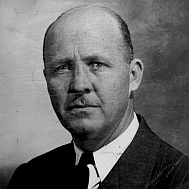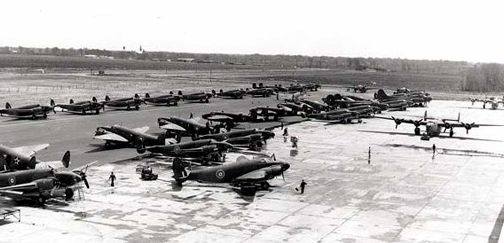Venturas, Mitchells and Liberators at Dorval, Québec, awaiting delivery by Ferry Command to the United Kingdom and points beyond, 13 May 1942. Photo: Dept. of National Defence / Library and Archives Canada / PA-114759.

Howard Watt, pilot with Ferry Command from March 1942 to mid-October 1943. Photo: Canadian Armed Forces, Directorate of History and Heritage, RAF Ferry Command Crew Cards.
Howard Watt was one of several hundred brave civilian pilots who flew bombers manufactured in North America across the oceans to the battle fronts where they could fight for the Allied cause during World War 2.
Everyone in our family knew that Uncle Howard had been a pilot in Ferry Command. But what did he actually do?
How rewarding to finally receive copies of the official “crew cards” giving details about the aircraft he flew, his destinations, and the dates of his flights! Sincere thanks to Mathias Joost, of the Canadian Armed Forces Directorate of History and Heritage, for his help in ferreting out this information.
What was Ferry Command?
When World War 2 was in its early months, it became clear to both politicians and senior air force people that combat aircraft would be needed in large numbers in the theatres of war across the ocean, and that the best way to deliver those airplanes was to fly them. That’s what Ferry Command was set up to do.
Flying across the North Atlantic and other oceans may seem routine now, but this was not the case at the start of World War 2. Early transoceanic flights had been carried out by daring pilots such as Charles Lindbergh and Amelia Earhart. It was 1937 before the possibility of commercial transatlantic flights was tested experimentally by British and American companies using flying boats. But the War provided even stronger impetus for the project of crossing the seas by air.
Ferry Command proved that long over-water flights could be safely made – and in the process, successfully delivered 9,442 aircraft. That’s the figure given by Air Commodore Griffith “Taffy” Powell who was senior air officer in charge of Ferry Command’s day-to-day operations for most of the War.
Answering the Call to Service
To pilot those aircraft, Ferry Command relied primarily on civilians. Like many other Canadian bush pilots, Howard Watt answered the call for experienced aviators. In the late 1920s and early 1930s, he had been a company pilot for Canadian Transcontinental Airways and Canadian Airways Limited, flying airmail along the rugged North Shore of the St. Lawrence River, and carrying freight into remote northern areas of the province of Québec. From the mid-1930s until 1941, he had his own business, providing transportation and freight service to communities along the St. Lawrence with two DH83 Fox Moths and a DH84 Dragon.
In March 1942, Uncle Howard became a pilot with Ferry Command, flying from the new airport at Dorval, on the western outskirts of Montréal. After the standard training period for all new hires, he began flying deliveries in May 1942. During his year and a half with Ferry Command, he delivered a total of 16 aircraft: 1 Baltimore, 4 Bostons, 3 Dakotas, 4 Hudsons, and 4 Venturas. Of these, 8 went to the U.K., 3 to Accra in the Gold Coast, 1 to Gibraltar, and the rest to locations closer to home.

Captain Howard Watt with Consolidated B-24 Liberator FL 919, nicknamed “The Magic Carpet.” Photo: Canada Aviation and Space Museum #2663.
Howard also flew three special flights, including a tour in Liberator FL 919 (nicknamed “The Magic Carpet”) that lasted from 30 August to 15 October 1942 and took him on the South Atlantic route from West Palm Beach and Miami through staging posts in the Caribbean and South America across to Africa, as far as Liberia (Roberts Field) and Accra.
With the special flights accounting for 7 weeks, and rest and recovery days another 30 weeks, Howard would have spent 33 weeks on regular ferry work, including the time required to find his way back to Montréal. This works out to an average of about 2 weeks per delivery.
Why Did Howard Resign?
In October 1943, Howard Watt’s days with Ferry Command came to an abrupt end. On 14 October, he returned to Montréal from Gander, Newfoundland, after his second trip there in nine days flying a Dakota (Douglas C-47/DC-3). That very day, he resigned “for personal reasons.” What prompted this sudden departure? If anyone reading this blog can shed light on this decision, please contact me!
Acknowledgements
Thanks to Marcia Mordfield of the Canada Aviation and Space Museum for finding the photograph of Howard Watt with Liberator FL 919. Special thanks to George Fuller for advice and encouragement, and to both George Fuller and Diane Wagner for critical reading of the draft of this blog.
Suggested Reading & Links
Christie, Carl A., with Fred Hatch. Ocean Bridge: The History of RAF Ferry Command. Toronto: University of Toronto Press, 1995.
http://www.donnamcvicarkazo.com/aviationgallery.html
McVicar, Don. Ferry Command. Shrewsbury, England: Airlife Publishing, 1981. Also North Atlantic Cat. Shrewsbury, England: Airlife Publishing, 1983. Check Amazon for e-book versions now available.
Powell, Air Commodore Griffith. Ferryman. Shrewsbury, England: Airlife Publishing, 1982.


Howard Watt, Howard Taynen and let me add Howard Wright. Is everyone associated to the Ferry Command named Howard? My father, Howard Wright, was the Chief Flying Instructor at #3 Elementary Flying School in London, Ontario until it closed in July, 1942. He then went to the RAF Ferry Command and flew 34 aircraft overseas before crashing a Mosquito bomber into the North Atlantic off Greenland in June, 1945. “They” never found him or his plane or his navigator. And Diana, thanks to you and this article, I have contacted the Directorate of History and Heritage to continue my search for information. I wish you continued success.
Very satisfactory to get a good lead when you have such an important search. I’m glad it worked out so well.
I wonder if you’ve seen Carl Christie’s book “Ocean Bridge”? Generally considered the bible on Ferry Command. There are a couple of references in his book to Captain Howard Stanley Wright, lost between Goose Bay and Bluie West 1 (Greenland) on 10 June 1945 in Mosquito KA237. According to Christie, the Mosquito was not considered a safe aeroplane yet. He also refers to Search and Rescue practices and issues.
My uncle Howard’s younger brother Bruce Watt was a pilot in Ferry Command for the duration of the Second World War (no, they were not all called “Howard”!). You’ll find several posts on the blog about some of the flights Bruce made, either aircraft deliveries or transport service. I’m working my way through all the listings on his Crew Assignment cards. When you get your father’s Crew cards, you’ll be able to check some details of his 34 deliveries. By the way, Bruce was also a flying instructor – in 1940 at #1 EFTS Malton.
Please keep in touch and let me know how your research is proceeding.
So nice to read some history on my great grandfather as I never got to meet him. I’m sure he was a daring man, but a smart head on his shoulders. I would love to read more about him or hear more stories . Thanks Michelle Kuiper
I am so very glad that you have done such an amazing, thorough and painstaking job of chronicling Howard’s career and life. I am also very very pleased that we could meet in Thornbury ON a while back. Keep up the good work cousin!
Excellent! Sure like to read more. Keep at it, Diana — please!
Great work Diana.
My uncle Ted Mahaffy was stationed at Dorval as the lead Meteorologist involved in providing the weather forecasts over the North Atlantic Routes for the Ferry Command.
Bob Galway
Many Canadians must have had family members involved with Ferry Command. I hope other people come forward with comments like yours.
Thank you for this piece of history, flying is taken for granted these days and these pioneers and hero’s in my eyes were key to not only delivering aircraft but proving their abilities on long transatlantic flights. A hero who is cautious and daring and proved their mettle on many occasions never has to explain why its time to move on.
Good insight, Don – thanks for that. But I’ll bet there was a reason, and a story. Maybe a new opportunity? With luck, one day I will learn more!
Diana
Diana….I have no concrete information on your question but my impression of my grandfather’s attitude to flight in general was that he was cautious as well as daring. Does this fit with your knowledge of him? If so, my own guess would be that he (or Auntie Flo) could have felt he was pushing his luck, had had enough close calls and that he had done enough to fulfill his duty.
Howard Taynen
Howard, you’ve hit the nail on the head with “cautious as well as daring” from what I’ve seen. You could be right that he felt he’d done his bit. But we may find another answer. Maybe someone who reads this will have that missing piece of the puzzle.
Well done Diana!